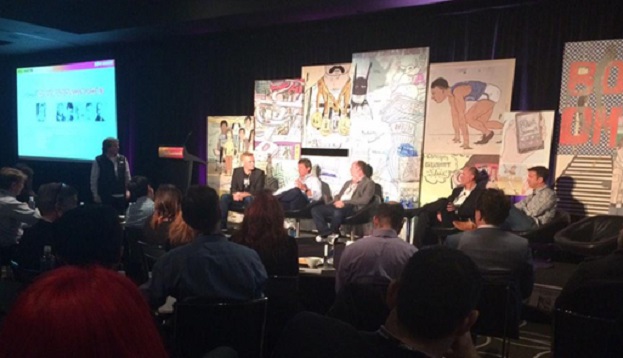Jim Louderback, managing director of Boomfeeder, moderated a panel of industry luminaries to discuss the state of entertainment marketing. He was joined by Kristian Segerstrale, COO of Super Evil Megacorp; Peter Levin, president of interactive ventures and games, Lionsgate; Andrew Stalbow, co-founder and CEO of Seriously; Andy Hess, evangelist for Epic Games; and T.J. Marchetti, CMO of Awesomeness TV.
Jim Louderback asked the panelists to define mobile – what is it “I think mobile is changing, it’s very rapidly becoming the primary consumption platform for gaming. It’s also shifting how we are thinking about marketing and our audiences,” said Segerstrale. “I do think it has migrated materially from a snackable item to a major part of our lives. The ability to have engagement with your audience is breathtaking,” Levin commented. “It used to be the fourth screen, but that’s not the case any more. It’s the first screen,” Stalbow said.
The question of mobile marketing versus marketing in general occasioned some interesting comments. “Yes, Gen Z is the core of our audience,” noted Marchetti. “When we think of creating content, 75 or 80% of all our views is on mobile.” Stalbow pointed out an important distinction. “What’s important is not whether it’s in your pocket, but the context of your use,” Stalbow said. “Are you truly mobile, waiting around your doctor’ office, or are you sitting on your couch That changes the nature of the content you create.”
“Yes, but is mobile marketing really different ,” Louderback queried the panelists. “It really bothered me when I worked at Disney that mobile was a separate group,” said Marchetti. “What is mobile marketing It’s marketing. It’s where your audience is.” Levin had an interesting perspective specifically on using mobile games as marketing tools. “It’s not separate,” said Levin. “One of the first edicts I ran internally was ‘No more promotional games.’ It’s basically spending a lot of money on your agency to create a sub-optimal gaming experience.”
Louderback pursued that topic with the panelists. “What do you think of advertisers that offer a product Stay away as far as gaming goes ,” Louderback asked. Segerstrale spoke from his experience with many game startups. “The amount of advergames that have really worked over 15 years is zero,” Segstrale declared.. “It simply does not work out. The best talent works on their own IP or a big project, and games are all about good talent.”
The nature of what customers expect from brands, especially entertainment brands, has changed, panelists noted, and thus marketing has to change along with that. “One clear expectation is interaction,” said Segerstrale, pointing out how game players expect replies when they ask a company questions about their game through various social media channels. “You have to be ready for that conversation, because those people will either be your biggest boosters or your biggest detractors. You can’t hide behind a web site, you have to be yourself.”
Stalbow made an important point about how the situation has changed for marketers. “The brand and the audience are suddenly connected,” Stalbow said. “If you think of the entertainment brands of the past they were never directly connected to their audience because they were always distributed by a third party.”

